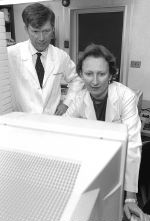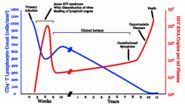Then in October, my boyfriend became very ill. After I rushed him to the hospital, they placed him in quarantine. I was told he had PCP (Pneumocystis pneumonia) and GRID. I was heartbroken, because I was not allowed to visit him and tell him I loved him. I watched him die as he held the teddy bear I had the nurse give him. That is when I found out they were incinerating everything in the quarantine rooms where the patients were being treated. Because funeral homes would not take the bodies, he had to be cremated.
"The doctor told me I would probably not live to see my 20th birthday, which was only six weeks later. I flew home to Florida to visit my family to come out -- except this time I was coming out not only as a gay man, but one with a new, deadly illness."
Then in February '82, I became ill. I thought it was just a cold, but went to the hospital anyway, where they immediately stuck me in quarantine. I was told a few days later they were pretty sure I had GRID, even though the type of pneumonia I had was not PCP. The doctor told me I would probably not live to see my 20th birthday, which was only six weeks later.
I flew home to Florida to visit my family to come out -- except this time I was coming out not only as a gay man, but one with a new, deadly illness. Luckily for me, I have a very loving family. While it was hard for them to deal with the fact their youngest son was going to die, I had the unconditional love and support of my family. Unfortunately, most of my friends with GRID were not so lucky. Most were disowned by their loved ones.
The whole reason I bring up the beginnings of HIV is because it caused a backlash in our country against gay men. Even in many places where being gay had become acceptable, people started fearing being around gay men, because there was much ignorance about HIV and AIDS. Gay men started losing their jobs, housing and families even if they were not HIV positive.
The next several years, as HIV spread among the gay male communities in the major cities, were a nightmare. We had no real medications to keep us alive. You would see a friend one day and then hear from friends a few weeks later the person had died. Some lived longer, but because of HIV wasting looked like skeletons. This started them being called the "walking dead," which I thought was horrible. During these years, Pride events were still occurring, but on a much smaller scale since we were so busy taking care of those in our community who were sick and dying. Many of the caregivers in the early days were our lesbian friends.
Then in 1995, medications called antiretrovirals became available, which for the first time helped people with HIV and AIDS regain some of their immune system. Although some continued to die, because their bodies were too weak, others of us started to get better. This is when I remember Pride events once again becoming a time of celebration and joy.
"When I am asked if Pride is still relevant in 2010, I have to say yes."
So when I am asked if Pride is still relevant in 2010, I have to say yes. First, Pride is a celebration of who we are and how we got to the present. If members of our community had not stood their ground at Stonewall in '69, we would not have the presence and freedoms we have today. But there is still much left to do.
First, we still do not have equal rights like the right to marry. My partner and I attended the Millennium March on Washington in 2000 and were one of the hundreds of couples who were "married" at the mass civil union in front of the Lincoln Memorial the day before the march. We had been together for several years and wanted to participate, because it was a demonstration to show that LGBT (lesbian, gay, bisexual and transgender) people deserve the right to be together and celebrate their love. Several friends flew to D.C. with us to watch the ceremony and celebrate our relationship.
By some twist of fate, my partner and I were taped by the cameras from CNN Headline News during the time we were saying our vows and when we kissed afterward. The next morning, as we were getting ready to leave for the march, we happened to see the coverage on the television. At the time, it was the longest male-to-male kiss aired on national television.
The fact that our love was recorded and shown on national television swelled us with pride. Everywhere we went the day of the march, people were stopping us and asking to have their picture taken with us. We even got to meet Cher, Chastity Bono, Margaret Cho and Judith Light, who were speakers at the march that day.
Sadly, the LGBT community still does not have the legal right to marry in most places in our country even today, so there is still much work to be done. With the right to marry come many other rights that our community is excluded from, like inheritance laws and rights of visitation. I cannot begin to tell you how many times I have seen one partner die, only to have the family of the dead partner come in and take everything. The surviving partner often has little recourse, even if he or she had legal documents drawn up.
Secondly, members of our LGBT community can still not openly serve in our military. My partner mentioned above was in the Navy for several years, but left when they started dishonorably discharging gays and lesbians. In the eyes of the military, we are still second-class citizens.
"To take for granted what Pride and Pride events truly mean is to forget our history and our future. We would not only be dishonoring those who sacrificed to give us the freedoms we do have today, but failing to gain true equality for future generations of our LGBT community."
Lastly, I think it is important we remember the past, and continuing Pride today is an important part of that. Before the 70s, our community had no rights. We were often persecuted by police, government officials and many of the churches. In many places in our country, there are still young men and women who feel like "there is no one else like them" -- like I did in my small city. They feel isolated and alone. Studies show sexuality issues are still a leading cause of suicides in teenagers and young adults.
"Those who cannot remember the past are condemned to repeat it." -- George Santayana
As a 29-year survivor and activist for the HIV/AIDS community, I am currently fighting for funding for lifesaving medications for Americans with HIV and AIDS. Eleven states have more than 1,400 people on AIDS Drug Assistance Program (ADAP) waiting lists. Florida started an ADAP waiting list on June 1, 2010. Illinois just announced they will be starting an ADAP waiting list also. This has happened because many in the HIV/AIDS community became complacent. They just assumed funding would always be there ... and they were wrong. When we let our guard down and forget the past, our present and our future suffer.
To take for granted what Pride and Pride events truly mean is to forget our history and our future. We would not only be dishonoring those who sacrificed to give us the freedoms we do have today, but failing to gain true equality for future generations of our LGBT







